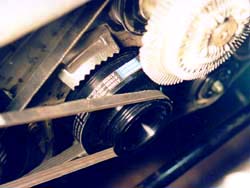Special thanks to Vince @ Courtesy Nissan for belt PNs & Kyle @ SGP for belt PNs & review of the procedure.
Timing: Anytime the radiator is out of the car is acceptable... like 60k maintenance. This one is installed on my '95TT.
Special Tools:
- 27mm socket
- Air wrench (not required, but very beneficial)
- 3 claw pulley puller
3 New accessory belts. The power steering belt went to a 3 rib in '94+ TTs
- Nissan PN# '90-'93 TT: A172M-59SSAVW, '94+ TT & all NAs 11950-32F10 Power Steering
- Nissan PN# A195M-97E0MVW Alternator
- Nissan PN# A192M-42LSAVW A/C
- Gates PN# '90-'93 TT: 040350 '94+ TT & all NAs: 030350 Power Steering
- Gates PN# 040390 Alternator
- Gates PN# 040365 A/C
- '90-'39 TT: 4 rib 35", '94+ TT & all NAs: 3 rib 35" Power Steering
- 4 rib 39" Alternator
- 4 rib 36.5" A/C
1. Get the front of the car in the air, about 16-18". Make sure all jack stands are properly placed, or better yet, use ramps on the front wheels, & all safety measures are taken. Make certain the rear wheels are e-braked & chocked, the crank will be wrenched during this, so the car moving off the stands is definitely possible if these steps aren't taken.
2. Remove bottom engine shielding (6 x 10mm). Drain the radiator (2.) by removing the radiator lid and the 'vent plug' on the opposite side of the radiator (1 x phillips). The plastic petcock on the lower back side of the radiator is poorly designed and I have only met up with 1 that worked correctly. Just unscrew it until fluid starts dribbling out into the bucket. Let it go until done, then move the bucket under the lower radiator hose where it goes into the radiator. Remove the hose from the radiator (1 x 10mm), hopefully the rest of the radiator fluid will make it's way into the bucket & not onto the floor.
3. Pull hoses off coolant tubes on the front of the engine, then remove bolts holding radiator retaining clamps (3. dot shows bolt head) in (2 x 10mm). Remove the lower radiator hose from the bottom of the car, minding where left-over fluid will end up. Remove the bottom part of fan shroud (3 clips). Remove the overflow hose from the radiator (right below and behind the radiator cap) neck and clips on the side of the radiator. Tuck the hose off to the side and don't let it fall down. It will drain the remote coolant resevoir. Remove the radiator.
4. Remove radiator fan (4 x 10mm) & fan clutch (4 x 10mm).
5. Loosen belt tensioner (1 x 12mm) on the power steering pump, then loosen the bolt slightly on the power steering pump mount (4. dot shows where the bolt head is) (1 x 14mm). This bolt is accessed through one of the holes in the pulley. Shift the car in neutral and put the torque wrench on the crank bolt to rotate the pulley where the bolt is accessable. Make sure to put the car back in gear afterwards. Loosen the tensioner locking bolt (5. dot shows where bolt is) (1 x 12mm).
6. Loosen belt tensioner on alternator (1 x 12mm), then loosen bolt slightly on the alternator mount (1 x 17mm) & tensioner locking nut (6. dot shows the back side of the tensioner lock) (1 x 12mm).
7. Loosen belt tensioner on the A/C compressor idler pulley (1 x 12mm), then loosen bolt on idler pulley (1 x 14mm) (7. dot shows locking nut on the idler).
8. Remove all three belts.
9. Remove crank bolt holding the pulley (1 x 27mm). An air wrench will make this simple, otherwise put the car in fifth with the parking brake on & do it the old fashion way. Leave the bolt in, but loosened, it has a detent in the head of it for the pulley puller to ride in, keeping yor threas from being harmed. Then use a pulley puller to remove the crank pulley (8. & 9.). Be careful not to loose the woodruff key in between the pulley and the crank. It is there to maintain alignment between them.
10. Install the new pulley. Make sure to get the pulley lined up on the woodruff key. Retorque crank bolt to 165lb.
11. Install new size belts, then assemble in reverse order. To get the power steering belt al the way on, shift the car in neutral an put the torque wrench on the crank bolt again to 'rotate' the belt onto the pulley. Make sure belt deflection is no more than 1/2" on the power steering belt & no more than 1/4" on the others at any midpoint after tightening, this is for new belts only (10.). More than likely, they will require tightening after a few days of use. The belts will squeal on start-up to let you know when.
12. Replace coolant by filling the radiator, then starting the car & letting it idle while continuing to fill as required. Watch the coolant temp needle while driving the first couple minutes to make sure the car isn't running low on coolant.Don't forget to check the coolant level in the overflow tank.
REV: 1-9-2000
© Twin Turbo Zs of Dallas - All Rights Reserved 2000
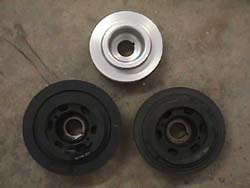
2.
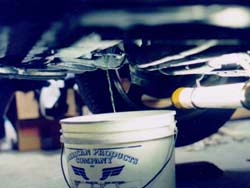
3.
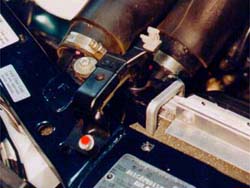
4.
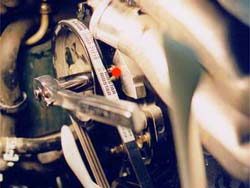
5.
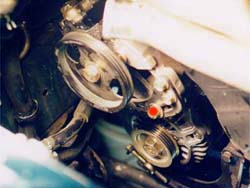
6.
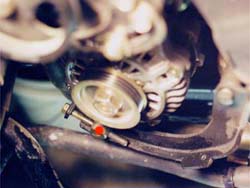
7.
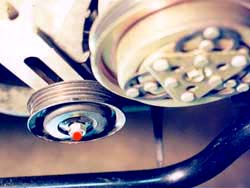
8.
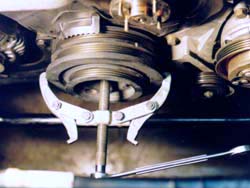
9.
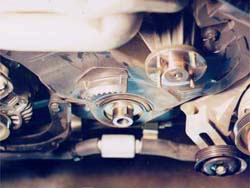
10.
